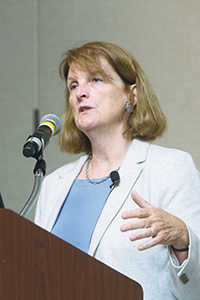By KEN LEISER
DALLAS — Catholic eldercare ministries are being challenged to attract and retain qualified workers, to maintain their Catholic identities in a consolidating sector, and to meet shifting expectations of seniors — all while keeping pace with a rapidly aging population, an aging services expert said during a pre-assembly seminar on the state of Catholic long-term care.

Photo by Jerry Naunheim Jr./© CHA
Susan McDonough is a consultant in Catholic eldercare and post-acute care at Ziegler, a specialty investment bank in Chicago. She and other panelists told about 100 people who gathered for the "Heart of Aging Services" event on June 9 that Catholic health systems will be forced to adapt to shifting market forces and demographics.
"Senior living and health care is becoming much more complex," said McDonough, who has served on the boards of Presence Health in Chicago, now part of Ascension/AMITA Health, and CHA. She is a former vice president of strategy and system development for Covenant Health in Tewksbury, Mass.
From 2020 to 2060, the U.S. population over age 65 is expected to nearly double to about 100 million, McDonough said. Today, the average age at which people move into independent living facilities is 80. This suggests that people are staying healthier and are working hard to retain their independence. When and if they make the decision to move out of their homes, many seniors will favor settings that are not institutional.
Still, a significant percentage of elderly Americans will have progressive debilitating conditions and will require higher levels of supportive care and services. For example, during the next six years, every state in the U.S. can expect the number of citizens 65 and over with Alzheimer's disease to increase by 12 percent.
Many people needing eldercare services will have financial as well as physical needs. About 9.3 percent will live below the poverty line, McDonough said.
Consumer expectations are growing, as well, she said. As Americans enter advanced old age, they want both quality of life and quality of care. "They want to have control over the settings they live in. They want to have choice," she said.
Roughly 80 percent of the nation's largest not-for-profit senior living providers are faith-based, McDonough said. Catholic health providers have the third-largest number of senior living units among multisite, not-for-profits, she added, "so we are a big portion of the marketplace in the United States."
But she added that among the 75 Catholic-sponsored facilities that changed owners or sponsors during the last 10 years, just 20 percent affiliated with another not-for-profit and just 8 percent affiliated with another Catholic organization. Sixty-five percent were sold to a for-profit organization, and the remaining 15 percent closed.
John Capasso, executive vice president of continuing care at Livonia, Mich.-based Trinity Health, said 84 percent of U.S. nursing home beds are occupied, which is "an all-time low." In comparison, short stay beds for rehabilitation for Medicaid and/or Medicare patients have an occupancy rate of about 90 percent. Capasso, one of the panelists during the session, said he does not expect nursing home occupancy rates to go back up to what they once were.
Meantime, in a full-employment economy, senior health facilities face an increasingly competitive market for workers. McDonough said health care and the social assistance employment sector, including senior living, is "at the top of the list in terms of sectors that are trying to recruit people and they're not finding the folks out there."
Sr. Nancy Surma, OSF, is vice president of mission integration with CHI Living Communities, a business line of Catholic Health Initiatives providing residential care to more than 2,500 people in Colorado, Iowa, Kentucky, North Dakota, Ohio, Oregon and Wisconsin. It is part of CommonSpirit Health. During the panel discussion, she stressed that those who operate eldercare facilities can't lose sight of the need to hire "the right people" to carry their mission into the future.
Still, it is a challenge to compete for good people given that nurse aide jobs are physically demanding, and facilities may be hard pressed to pay wages that exceed the pay offered in "much easier" jobs such as being a grocery store clerk.
In addition, Catholic systems can be challenged to help administrators who arrive from for-profit systems understand "at a deeper level" the mission of the Catholic eldercare ministries, she said. "When we have to start at square one about what mission is at a Catholic institution, it takes a lot of work."
Catholic systems have to be more agile, said panelist Rita Turley, a member of the Leaven Ministries, the public juridic person for SCL Health. She is a health care consultant. Historically, faith-based systems have tended to be risk-averse and slow to change. "The bottom line is going to drive us to change," she said. "We need to start to identify that strategy for our future. It has to be different. Much different."
